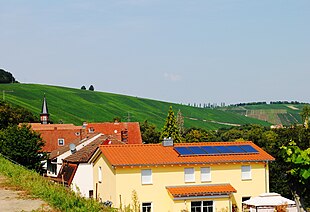Escherndorfer Fürstenberg
Escherndorfer Fürstenberg (also Köhler Fürstenberg ) is one of the most famous vineyards in the Franconian region . It is located in the districts of Volkacher districts Escherndorf and Koehler in the Lower Franconian district of Kitzingen .
Geographical location and geology
The vineyard lies on the edge of the Volkacher Mainschleife . It runs along the district road KT 31, which runs parallel to the Main . Escherndorf lies in the north and northeast, above whose other location Lump the vineyards of the Fürstenberg stretch as far as Astheim . In an arc towards the south, the vineyard runs past Köhler to the boundary at Neuses am Berg , a district of Dettelbach . The Escherndorfer Fürstenberg occupies the slopes of the so-called Langenberg and the Escherndorfer Berg or Vogelberg.
The Escherndorfer or Köhler Fürstenberg today covers an area of more than 60 hectares , of which only 55.32 hectares are classified as first location. The area has decreased since 1993, when around 85 hectares were still planted with vines. The vines run up the 200 to 260 m high mountain at an angle of 60%. The grape varieties Silvaner , Pinot Blanc and Chardonnay are grown on the soils made of shell limestone , Lettenkeuper and loess loam . The vineyard is part of the major site Volkacher Kirchberg in area Volkacher Mainschleife .
history
The grapevine was first identified on the Main Loop in 906. In a document, King Ludwig confirmed the child that his father had donated to the Fulda monastery . In addition to several places, vineyards around the Vogelsburg had come to the Bonifatius Abbey. It is likely, however, that the wine was brought to the region by the Franconian settlers as early as the 7th century .
In the course of the establishment of a Carmelite monastery on the Vogelsberg in 1282, the Langenberg became a contiguous wine-growing area. At that time the population in Escherndorf already consisted almost exclusively of winegrowers . The monastery Ebrach that prevailed after 1500 over part of the village, also owned several vineyards on the mountain. Köhler probably also emerged as a winegrowing village, but in bad wine years the population often had to help out in the Escherndorf vineyards.
The Langenberg faces east in the Koehler district so that the vines do not receive the same amount of sunlight here. In the 19th century, Köhler quickly became impoverished after the phylloxera appeared . In Escherndorf, viticulture remained an important branch of the economy because it was possible to continue to export the high-quality "mountain wines". It was only after the Second World War that Köhler began growing wine again.
In the course of the land consolidation, the vineyards had to be merged into individual layers. In the implementation of the Wine Act of 1971, all locations were combined into the single location "Fürstenberg". A total of 33 locations had to be cleaned up, including the two Köhler locations “Engelsgepräng” and “Langenberg”. The northernmost parts of the vineyard are on Prosselsheimer Weg.
Wineries (selection)
Several renowned wineries now own vines on the slopes of the Langenberg or Fürstenberg. In addition to some locally recognized businesses, there are also a number of nationally known wine growers and excellent goods. Several goods have been awarded by the Association of German Predicate and Quality Wineries (VDP).
- Johann Arnold winery , Iphofen
- Michael Blendel winery, Escherndorf
- Andreas Braun winery, Volkach
- Michael Fröhlich winery , Escherndorf
- Horst Sauer winery , Escherndorf
- Rainer Sauer winery , Escherndorf
- Winemaker Sommerach , Sommerach
- Winzergemeinschaft Franken , Repperndorf
- Egon Schäffer winery , Escherndorf
- Zur Schwane winery , Volkach
- Weingut am Vögelein, Nordheim am Main
The Fürstenberg was classified as the first location by the Association of German Predicate and Quality Wineries.
literature
- Hans Bauer: District of Kitzingen. An art and culture guide . Market wide 1993.
- Gerhard Egert: The Escherndorfer Lump . In: Ute Feuerbach (ed.): Our Main Loop. 1993-2007 . Volkach 2008. pp. 10-16.
- Gerhard Egert: The wine-growing communities Escherndorf and Köhler at the beginning of the 19th century . In: Ute Feuerbach (ed.): Volkach. 906-2006 . Volkach 2006. pp. 306-312.
- Barbara Holtz: The vineyard names in the Kitzingen district . In: Andreas Pampuch (Hrsg.): Nature and landscape of the district of Kitzingen II. Volume . Kitzingen 1981. pp. 124-160.
- Ado Kraemer: Escherndorf and its wines . Wuerzburg 1964.
- Franz Pfrang: The history of viticulture on the Main loop . In: Ute Feuerbach (Ed.): Our Main Loop. 1978-1992 . Volkach 2008. pp. 23-28.
Web links
Individual evidence
- ↑ Vineyard information: Escherndorfer Fürstenberg , accessed on July 2, 2018.
- ^ Bauer, Hans: District of Kitzingen . P. 190.
- ↑ VDP-Franken: Erste Lage Fürstenberg , accessed on July 2, 2018.
- ↑ Egert, Gerhard: The Escherndorfer Lump . P. 10
- ↑ See: Egert, Gerhard: The wine-growing communities Escherndorf and Köhler in the 19th century .
- ↑ Holtz, Barbara: The vineyard names in the district of Kitzingen . P. 128.
- ↑ Weingut-Blendel: Wine , accessed on July 3, 2018.
- ↑ Weingut Horst Sauer: Homepage , accessed on July 3, 2018.
- ↑ Weingut Rainer Sauer: Homepage , accessed on July 3, 2018.
Coordinates: 49 ° 51 '24.7 " N , 10 ° 10' 2.3" E

